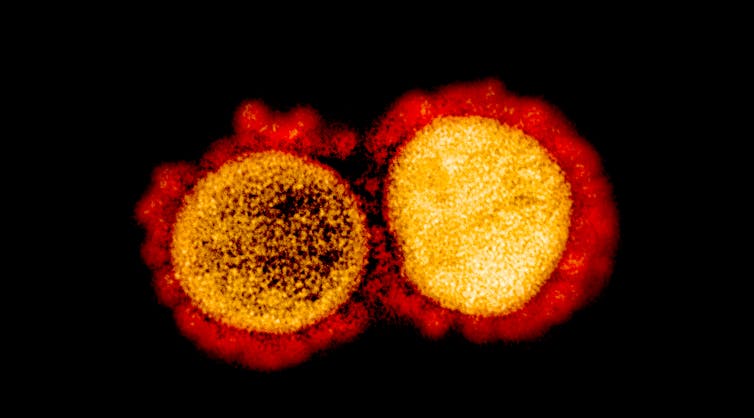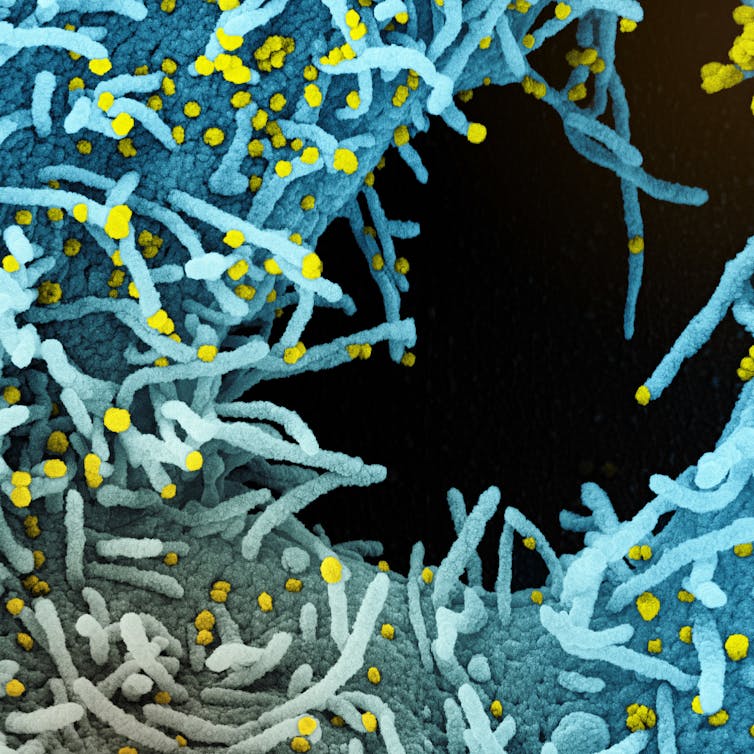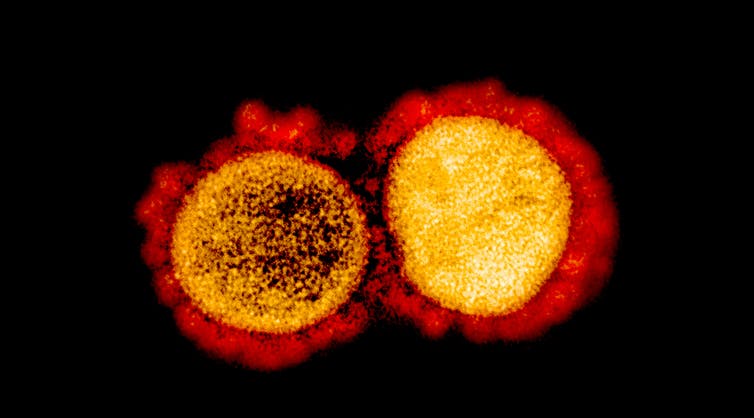
Franck Courchamp, Université Paris-Saclay
In this interview, Franck Courchamp, director of research at the CNRS and holder of the AXA Chair of Invasion Biology at the University of Paris-Saclay, puts himself in the place of the SARS-CoV-2 virus, which has infected nearly 60 million people worldwide and killed more than 1.4 million. In addition to its unexpected form, this interview also gave the author an opportunity to change our perspective on the stakes of the pandemic and the lessons that it may hold for us.
Coronavirus, who are you?
I’d like to start by saying, in all modesty, that I am the king, and the name you gave me proves that – corona is Latin for “crown”. Strangely enough, my very simplicity confuses you. You can’t even decide whether or not I’m alive, and you’re still wondering the same thing about all my fellow viruses.
Personally, I don’t much care where you classify me. You could say I’m a sort of microscopic biological machine, with a very simple program: survive and reproduce in order to live on from one generation to the next. In that respect, I have exactly the same goal as any living species.
The fundamental difference is that I only need the bare minimum to achieve that goal: I just get into my host’s cells, borrow whatever I need to keep operating, and hijack the cells’ machinery to make copies of myself. I then release my clones – brand new viral particles – and they set out in search of other cells to infect. We coronaviruses can produce a thousand copies of ourselves per infected cell in barely 10 hours.
Yet in spite of all that, I’m not big. My diameter is about 100 nanometers or one ten-thousandth of a millimeter.
Visualizing the Relative Size of Particles 🦠
Full version: https://t.co/jNyh0OFvor pic.twitter.com/sBmqoqCznd
— Visual Capitalist (@VisualCap) October 10, 2020
So I’m a thousand times smaller than bacteria (which are 10 to 100 times smaller than a human cell) – in other words, 50 trillion times smaller than a drop of water. A single one of your cells is way bigger to me than an immense city is to you.
Why do you infect people?
That’s a strange question. Humans are my habitat, my ecosystem, my resources… It’s like me asking you why you live where you do – on a mountain, or a plain, or wherever.
But I don’t have a sedentary lifestyle like yours. I’m a nomad because my vessels – the people or animals I infect – aren’t immortal. To survive, I have to find a new host before the first one disappears. I admit we’re sometimes responsible for their untimely demise because the bodies of some of our hosts don’t like it when we start proliferating. Others fall victim to the war their immune systems wage on us, which can sometimes spiral out of control.
How do you infect us?
I use simple means. You’ve already discovered some of my secrets – that I can travel in saliva and sneeze droplets, and stay on people’s hands or on objects touched by hands.
I can squeeze inside a milliliter of saliva with 100 billion of my fellow coronaviruses and survive for five days on plastic, or a week on a surgical mask. I may not be very sophisticated, but I’m really efficient… like all viruses, in fact. We’re endlessly adaptable.
Consider the problem of spreading to another host. Luckily you humans produce nasal mucus, especially when you’re infected by one of us respiratory viruses. An infected person who sneezes is transformed into a powerful spraying machine that can transport us to our next victims at a speed of over 50 km/h, in a cloud of tens of thousands of droplets. These also end up on your hands, which you put all over the place. All this provides a very practical means of transport and helps us spread more easily.
Other viruses choose different fluids. For example, some of us give you diarrhea, which results in highly efficient mass spreading. Others hang around in your seminal or vaginal fluid and spread when you have sex. You can isolate all you like, but, as a species, you have to reproduce at some point…
Some viruses change their hosts’ behavior to spread more easily – like rabies, which causes confusion, aggression, and a tendency to bite. And it’s difficult to fight against that, isn’t it?
Why do you viruses have it in for us humans?
Don’t be so self-centered! We don’t have it in for you – we neither love nor hate you. You just happen to be our favorite vessels and make things easier for us in so many ways. To start with, humans often live in densely populated places and their global population is interconnected, which makes potential hosts almost systematically available to us the world over.
I made that quite clear over the last year. After starting out from somewhere in China, I soon turned up on every continent and in the remotest corners of the planet – and I don’t even have legs. Other animal populations are generally fragmented, limiting our chances of dispersal and confining us to small areas. But human beings are a whole other kettle of fish, so as to speak. As the song goes, “Ain’t no mountain high enough, ain’t no valley low enough, ain’t no river wide enough” to keep us from getting to you. We travel from host to host by car, boat or plane: the world is our oyster. Given how restlessly humans move, you helped us create initial infection sites on every continent in less than a week.
What’s more, humans keep a large part of their population in pretty deplorable sanitary conditions, which really helps us. Not to mention the behavior of some of your leaders, who aren’t ethical or intelligent enough to behave responsibly. This creates opportunities for us in some parts of the world, where the epidemic is downplayed or denied to avoid the problem of having to face up to it…
But you didn’t infect human beings at first…
That’s true. I used to depend on other animal species. However, by replicating over and over in the animals’ infected cells, some clones mutate and become slightly different. And, from time to time, one of those mutants hits the jackpot: its mutation allows it to survive and spread via other animals than those its fellow viruses usually infect. Then you have a new strain of the virus, ready to change host.
But it’s not just a question of having the ability to infect a new animal species, you also have to get close enough to be able to infect it. The likelihood of those events coinciding is pretty small, but two factors work in our favor.
First, we’re very, very numerous. For the 6,500 or so mammalian species, there are about 320,000 different viruses that can infect mammals. And the more the viruses, the more the mutations.
Second, humans’ many contacts with other species increase our chances of encountering and infecting you. And those opportunities are increasing thanks to your intrusions into the territories of species that are already stressed by being hunted, deprived of their natural habitats and resources, and subjected to pollution or climate change. Then there are all the wild species you hunt, put in cages, pile up in markets and eat, sometimes improperly cooked, to the tune of millions of tons per year. That’s how the HIV, SARS, l’Ebola, Zika and MERS viruses managed to infect you in recent years.
 Colonized scanning electron micrograph of a cell (purple) heavily infected with SARS-CoV-2 virus particles (yellow), isolated from a patient sample. NIAID/NIH
Colonized scanning electron micrograph of a cell (purple) heavily infected with SARS-CoV-2 virus particles (yellow), isolated from a patient sample. NIAID/NIHI might add that the result is pretty much the same when a virus infects a domesticated species rather than a human being. When you encroach on bats’ territories and set up massive pig farms near their ruined habitats, you’re increasing the chances that a bat virus (such as the Nipah) will shift to the pigs that come into contact with bat saliva or excrement (which contain viruses). And as the pigs are crowded together and kept in wretched sanitary conditions, the chances of transmission increase and nothing can stop us.
Picture a bunch of stressed and sickly hosts, living in their own excrement among the corpses of their fellow-creatures… it’s an all-you-can-eat buffet for a virus. That’s how swine flu and the H5N1 bird flu managed to infiltrate poultry and pig farms a few years ago. Concentrations of sickly hosts result in incredible concentrations of virus, which boosts our chances of spreading from domesticated animals to humans. Like the H5N1 or the Nipah (whose case fatality rate is 40% to 75% in humans).
As I said before, my main problem is infecting the first human. Your globalization system does the rest. It’s as if you set it up to allow for the free circulation of viruses. So thanks very much, merci beaucoup, danke schön, 衷心感谢, muchas gracias, большое спасибо, etc.
Do you realize the damage you do?
We mean you no more harm than a sheep does to a clump of grass. If we had any say in the matter, we’d obviously prefer our infected humans to stay alive and keep accommodating us indefinitely. But because our hosts sometimes die, we have to replicate quickly so that we can infect another host before the first one disappears. This intense replication causes symptoms that can be harmful or even fatal. One of the problems is that if we just chill out and lie low, and if we don’t find a good hiding place in your body, our initial small numbers risk being overcome by your immune systems. It’s not easy to strike a balance between surviving without doing you too much harm and being totally wiped out.
Anyway, we viruses and the species we infect are usually linked by hundreds of thousands of years of co-evolution and by now are relatively well “adapted” to each other. So, in the vast majority of cases, there’s little damage on either side.
Above all, you mustn’t forget that we viruses play an important regulatory role on other living populations (micro-organisms, plants, animals, etc.). If we all disappeared, they might end up overpopulating and using up all their resources, which would put them at risk of starving to death… Actually, we’re said to be of major importance for the ecology and evolution of the living world.
What’s more, a lot of viruses are beneficial to you. For instance, they kill certain bacteria that you’re not too keen on, either. Some researchers have even succeeded in using viruses instead of antibiotics to kill bacteria. And let’s not forget that many viruses have what could be called a “neutral” effect: in humans (since you’re so self-centered), some 5,000 different viruses have been discovered, but less than 3% are “pathogenic”, i.e. the cause of an illness. Which is not very many, when you think about it.
Finally, there are all the viruses that you’re not interested in because they’ve shown so little interest in you. They’re present in the soil, suspended in the air, floating in the water, and are in plants, insects, starfish… For example, there are a million viruses suspended in one liter of seawater. In fact, there are so many viruses suspended in the oceans that, despite their ridiculously tiny size, they would stretch beyond our neighboring galaxies if they were laid end to end.
As I’ve said, viruses are everywhere, even though you can’t see them. Sometimes they’re right in front of you and you don’t even recognize them, like the amazing giant viruses, bigger than the bacteria that scientists used to mistake them for.
Actually, where do you viruses come from?
I suppose you mean when do we come from? Well as a matter of fact, we’ve always been around. Long before human beings ever existed, and long before even your oldest animal ancestors. Some people say we’re older than the oldest bacteria. We were already present at the origin of life and have played a central role in evolution, particularly by allowing for gene transfer – not from one generation to the next, but between species. We’re so old that some of us have integrated into human genomes and become a part of you.
In all, almost 10% of the human genome is virus DNA, integrated into your chromosomes. And some of the new genes we viruses have given you are important, or even essential. In mammals, for example, the only reason the mother’s immune system doesn’t reject the embryo as a foreign body (a hybrid between the father and mother) is the existence of the placenta, which evolved from a virus integrated into your genome. Hey, don’t worry about thanking us.
And what about you, coronavirus SARS-CoV-2? Where do you come from?
Which species did my ancestors infect before they moved on to you? I don’t know. But does it matter whether they were bats, pangolins, monkeys or something else? What would you do if you found out? Would you stop poaching and eating that particular species? Would you wipe it out? Would you do the same to all the species whose viruses you might catch? That’s obviously out of the question – there’d be hardly any animals left.
Anyway, why are you looking for culprits when it’s obvious who they really are? Aren’t the real ones the people who stir things up by upsetting virus-animal systems that had managed to remain pretty much self-contained for millions of years? If you tease a cat and it scratches you, will you eliminate all cats? Wouldn’t it be better to stop pulling their tails?
How can we get rid of you?
In theory it’s quite simple. You just need to think of an epidemic as a forest fire. Both are natural phenomena, but they can get out of control when you play with the laws of nature. Fires, for example, are fueled by a combination of favorable conditions such as the accumulation of deadwood. After a strong initial blaze they generally die out when they occur in areas where the trees are too far apart for the flames to move from one to another (the equivalent of your social distancing), or where the tree species are less flammable (immunized against fire).
The situation is pretty much the same with natural epidemics. They appear then keep spreading until contagion is slowed when the majority of infected people fail to contaminate others – because they don’t encounter any (thanks to social distancing and quarantine), or because the people they meet have acquired immunity (during a previous infection or by vaccination). If the infection rate slows, the epidemic will fade out and eventually disappear.
So what really matters most is learning how to avoid the next of your fellow viruses?
Yes indeed, because it’s not a question of whether the next cross-species virus will threaten humans, but of when.
Will you be ready? You’ll need to react quickly, because more and more epidemics have spread from wild animals in recent years, and your societies on several continents have already had a taste of some of my cousin viruses…
We emerging viruses have killed millions of humans, sometimes striking at random and sometimes targeting specific categories – the most physically vulnerable, in the present case. We’ve jeopardized your economic and political systems, locked you up in your homes in fear and prompted the craziest conspiracy theories. What lessons have you learned?
What do you have in store for us in the future?
I’d be hard put to answer that question: my numerous offspring and I infect and mutate at random. If you survive my presence in your body and recover, will you be immunized against my return? I don’t know and don’t care. Will you be able to keep me at a distance with your masks and your social distancing during the second wave or third wave? That’s what we’ll find out together.
One thing’s for sure: I won’t be exactly the same from one year to the next. Remember, we viruses mutate. And if we’re very numerous – for example, when millions of humans are infected, which is the case at the moment – our mutations are more numerous too.
À lire aussi :
Coronavirus origins: genome analysis suggests two viruses may have combined
Most mutations result in less viable, less contagious or less virulent strains that soon die out. But, less frequently, mutations can lead to more contagious or deadlier strains. Although these more dangerous mutations are unusual among coronaviruses, the harder you find it to keep us in check, the more prolific we become, and – logically – the greater the chances of a more dangerous strain emerging…
But rest assured: no virus becomes so deadly that it wipes out its host population. Quite simply because that would mean destroying its own resources, ecosystem and environment – destroying itself, in other words. I may not be intelligent, but I’m not so stupid that I’d destroy my own environment. Who would be that crazy?

Created in 2007 to help accelerate and share scientific knowledge on key societal issues, the Axa Research Fund has been supporting nearly 600 projects around the world conducted by researchers from 54 countries. To learn more, visit the site of the Axa Research Fund.
This article was ranslated from the French by Sally Laruelle for Fast ForWord and Leighton Walter Kille of The Conversation France.![]()
Franck Courchamp, Directeur de recherche CNRS, Université Paris-Saclay
Cet article est republié à partir de The Conversation sous licence Creative Commons. Lire l’article original.




